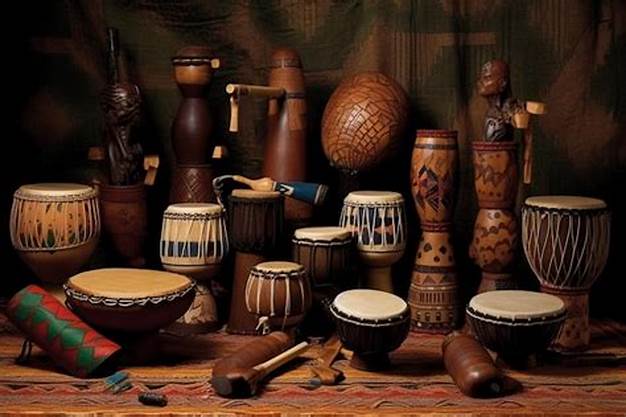**Exploring the World of Percussion Instruments Beyond the Djembe**
I love djembe, congas, dunun, bongo, and shekere as much as the next person, but did you know there is an entire world of percussion instruments out there? There is absolutely no reason every person needs to play a djembe, especially as a super cranked-up solo drum when most people don’t bother to study or learn how to play it properly.
I see individuals using mallets on djembes and sticks. Why not choose a drum that was meant for sticks and play that instead? While djembe and its music are undeniably beautiful, there are countless other percussion instruments worthy of exploration.

or instance, many are drawn to the rich sound of the dunun. However, traditional practice often has these drums played by one person at a time—either with or without a bell—in an ensemble. You can achieve just as much depth from a single dunun with a bell if you learn how to play it effectively.
Throughout West Africa, Central Africa, and other regions of the world, you’ll find an incredible array of percussion instruments. Here is a very small list of some examples, keeping in mind there are hundreds more:
### Countries and Their Percussion Instruments
1. **West Africa**
– **Djembe** (Mali, Guinea, Senegal)
– **Dunun** (Mali)
– **Balafon** (Mali, Burkina Faso)
– **Ngoma** (Various countries)
– **Kora** (Senegal, Gambia; a 21-string lute that combines melody and rhythm)
2. **Central Africa**
– **Ngoma** (Democratic Republic of Congo, Uganda)
– **Bulu** (Cameroon)
– **Adungu** (Uganda; a string instrument that complements rhythmic elements)
– **Mbayani** (Central African Republic; a traditional hand drum)
3. **Brazil**
– **Surdo** (Conga-like bass drum in samba)
– **Pandeiro** (Frame drum)
– **Caxixi** (Shaken percussion made from a woven basket)
– **Berimbau** (A single-string percussion instrument)
– **Atabaque** (Tall drum used in Afro-Brazilian music)
4. **Cuba**
– **Conga** (Tall barrel-shaped drum)
– **Bongos** (Small paired drums)
– **Guiro** (Gourd instrument)
– **Timbales** (Two-headed drums often used in Cuban music)
5. **Peru**
– **Cajón** (Box drum, often used in folk and Afro-Peruvian music)
– **Charango** (Stringed instrument often used for rhythmic accompaniment)
– **Bombo** (Large bass drum used in folk music)
6. **India**
– **Tabla** (Pair of hand-played drums)
– **Dholak** (Two-headed drum)
– **Mridangam** (Traditional drum used in Carnatic music)
7. **Japan**
– **Taiko** (Large traditional drums, often used in festivals)
– **Shime-daiko** (Smaller, high-pitched taiko drum)
8. **Middle East**
– **Darbuka/Doumbek** (Goblet drum)
– **Frame drum** (Various forms, including the daf)
– **Zurna** (Wind instrument often paired with percussion in folk music)
9. **Native America**
– **Powwow Drums** (Large circle drums used in traditional ceremonies)
– **Hand Drums** (Various sizes used for singing and storytelling)
10. **Ireland**
– **Bodhrán** (Frame drum played with a tipper)
– **Bone Fiddle** (Percussion instrument made from bones)
11. **Italy**
– **Tamburello** (Frame drum)
– **Conga** (Used in traditional tarantella music)
12. **Russia**
– **Bayan** (Accordion-like instrument played with rhythmic patterns)
13. **Indonesia**
– **Gamelan** (A traditional ensemble featuring various percussion instruments like metallophones and gongs)
14. **Turkey**
– **Def** (Frame drum used in folk music)
– **Cajón** (Adapted from Afro-Peruvian influence)
Each of these instruments offers a unique sound and cultural context, enriching the global tapestry of rhythm and music. There is indeed a world full of world percussion instruments to enjoy!
For many of us, playing djembe for recreation and leisure has become a fad, and that’s fine It’s a fun, healthy fad! But you don’t have to buy the white Honda because your next door neighbor has one!
And while I totally enjoy the study and practice of djembe I want to spread the message that there is a vast world of percussion waiting to be explored by anyone, even those with the slightest interest. Please google search and use your Youtube skills to investigate all the possibilities!
Many people stop playing altogether because the djembe can be tough on the hands, or they may encounter wrist problems or for many other reasons. Exploring alternative percussion instruments can not only enhance your musical journey but can also provide a more enjoyable and healthy experience.

